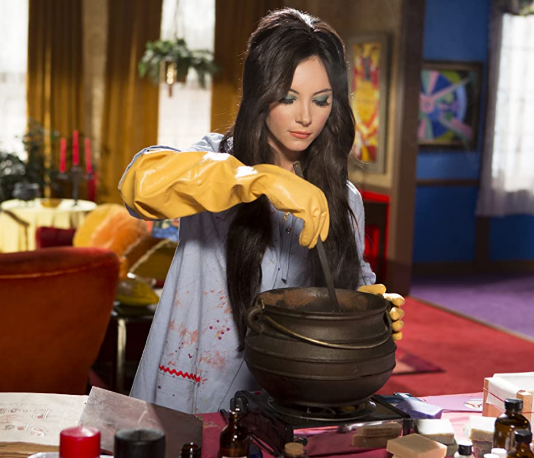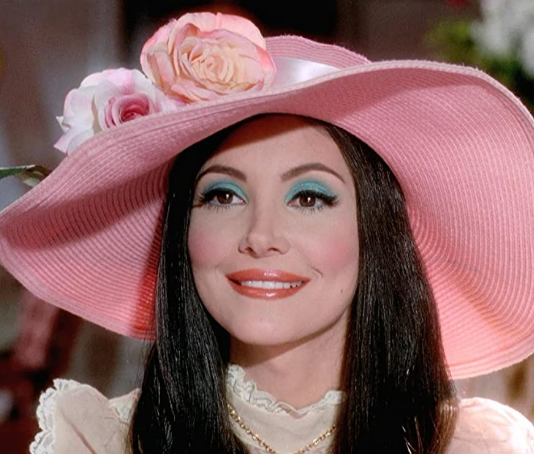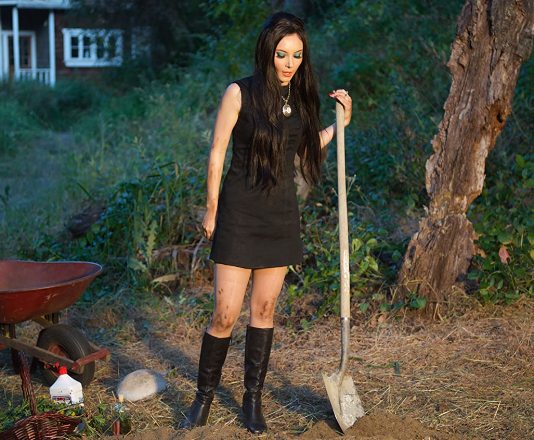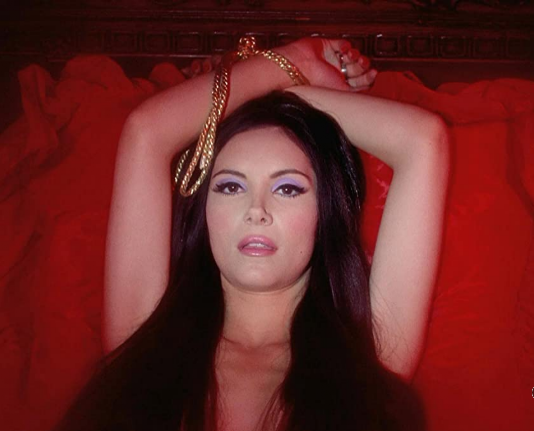AN INTERVIEW by JOHN PATTERSON with ANNA BILLER,
published in THE GUARDIAN, March 2017
“THE big question,” says Anna Biller, “is what would happen if men loved women as strongly as women want them to; the way women crave to be loved by men. Men are known for being much less emotional than women, but, in my experience, they’re much more emotional. And that’s why they won’t, or can’t, open that gate – it would destroy them. And that’s what kills all the men in my movie – having to experience their own feelings.”
Biller is the director of The Love Witch, a feminist, style-drenched fantasy of witchcraft in the modern era, rendered in self-consciously stilted and melodramatic dialogue against a mise-en-scene of eye-popping coordinated colours and costumes. Elaine (Samantha Robinson) is a young witch who flees San Francisco after the mysterious death of her lover and fetches up in a picture-postcard small town in northern California. There, she beguiles a succession of men with her beauty, spells and potions. But none can face the power of the emotions she arouses in them and so the corpses pile up again.
Biller and I meet in an appropriate locale, the Tam O’Shanter Inn, something of a Los Angeles institution. Ninety-seven years old and soaked in movie lore and history, it is like a classic Mildred Pierce, meat-and-martinis 1940s joint, once a popular movie-star hangout. We lunch among original drawings by Walt Disney (a beloved regular in the postwar years) at John Wayne’s favourite table, and talk movies – as is only proper here.
With Biller, the references come thick and fast. In The Love Witch, she channels, among others, 50s Hitchcock, Douglas Sirk’s lurid lushness, Rainer Werner Fassbinder’s deadpan gaze, Nicholas Ray’s poetry, Sam Fuller’s tabloid style and Todd Haynes’s revisionist sexual politics. She cites the salacious, female-driven movies of the early 1930s – before the Hays Code instructed that a film should not “lower the moral standards of those who see it” – such as Baby Face, in which Barbara Stanwyck seduces her way to the top of an outrageously phallic corporate skyscraper, floor by floor, man by man. Then add the Technicolor, widescreen, haute-Hollywood “women’s pictures” of the 50s, a touch of Hammer Studios, The Wicker Man, Rosemary’s Baby and any number of studio melodramas and musicals.
Much of the music is borrowed from Ennio Morricone’s scores for 60s giallo thrillers. And yet it’s very much its own, subversive work of feminist art, alternately bold and sly in its bone-dry humour.


We meet on the Monday after the weekend of the Women’s Marches across the globe. The Love Witch was released three days after the election, itself an 18-month-long tsunami of grotesque misogyny and sexism. Did that make a difference to its reception?
“It came out right on time,” she says. “As soon as the election happened, the reviews became very different from what they had been before. They talked about the character and her situation as if it were now something current and relevant, which they hadn’t done before. Then they started calling her, ‘The Love Witch #nastywoman,’ you know, grab-her-by-the-pussy jokes. People became more conscious that this movie’s ideas were relevant now, rather than seeing it as some fun little retro thing. And those scenes towards the end, at the bar, with the near-rape and the crowds shouting: ‘Burn the witch!’ – that all feels pretty Trumpian all of a sudden.”
The film took seven-and-a-half years to complete, and Biller handled nearly every task. She wrote, directed and edited, storyboarded every shot and worked closely with her cinematographer, M David Mullen, an expert in reproducing classical camera styles. She designed (and sometimes built) the lavishly detailed sets and the many vibrant costumes (many of which she stitched herself). Her own paintings adorn the sets, and she wrote special music and songs and commissioned musicians to perform them. Hers is a deeply artisanal, handmade, hands-on, highly controlled species of independent film-making that one is surprised and gratified to find still exists.
“It’s not important that I do it all,” she says. “It’s important to be the right tone. I think I’ve been able to achieve what I’m seeking, but I don’t quite know how to describe it. I’m constructing as I go along; I discover things while I’m working.”
Biller grew up around her painter parents and their bohemian friends in Santa Monica Canyon, and calls herself a “nerd who was always watching old movies”. She studied art and film at UCLA and at Cal-Arts, the Disney-backed LA art school, whose faculty included Thom Andersen (Los Angeles Plays Itself), minimalist director James Benning and feminist film-maker Nina Menkes. Hence, perhaps, her decentred, off-Hollywood, questioning brand of film art.


One thing Biller wants to make clear is that her work isn’t interested in the exploitation film-making of the 60s and 70s. Some have drawn links with the Russ Meyer of Beyond the Valley of the Dolls, a comparison she rejects, along with most movies of that era and kind.
“It’s the exact opposite of what I’m trying to do. That stuff is interesting in the history of censorship, but they’re often just really bad movies. I’m in conversation with earlier movies and with my own fantasies about being a woman, and overthrowing patriarchal oppressions that I face in my life. I can’t get into the mind of a male producer in the 1960s who is making exploitation because those films were made for men’s pleasure. They didn’t include women as a viewer or spectator, whereas a movie like Marnie does. I just don’t really have a connection to exploitation, because I see it just as a precursor to pornography. I am in conversation with the pornography that’s all around us.”
Yet some of those ideas did arise in her 2008 debut, Viva. “It was a kind of Candide for the sexual revolution, a 1970s housewife being dragged through the sexual revolution by her husband. It’s a comedy about the kind of strange experiences she has, but it’s kind of an exposé on the sexual revolution and Playboy-type male fantasies, and how it wasn’t really so great for women. People don’t ask themselves: what is inside the minds and the consciousness of those women, those centrefolds? What do they think about this? The woman is literally at the centre of everything and yet she’s not there at all.
“Maybe there is a little of that in The Love Witch: the sense that you take the woman, the objectified sex symbol, and you ask what’s inside her mind. The queasy thing about it is how the left has appropriated that kind of free sexual politics in a way that’s not really that good for women. So that if you complain about some of the problems for women in the sexual revolution, you’re looked at as a rightwing prude. The sexual revolution promised all kinds of freedom to women, and none of it was accomplished – at least, not for women.”
She also cites other female movie types whose voices she would like to reclaim: the sexually aggressive, confident women of the pre-Hays-Code era (when many more screenwriters were women), film-noir femmes fatales such as Ann Savage in Detour and Jane Greer in Out of the Past, projections of male postwar anxiety and misogyny. “I’m doing that with The Love Witch, reclaiming the figure of the witch, the femme fatale, an old sort of male fantasy figure, and make it a femme fatale seen from the female side.”
Her next project, then, initially seems a bit of a curveball. “It’s a Bluebeard movie! I’ve always loved Bluebeard movies, or movies of that kind of plot – Gaslight, Caught, Jane Eyre – all those movies where women are terrified of their husbands, whether the husband’s evil or not, like in Suspicion or Rebecca. The new wife, the new husband – the unknowable male.” Maybe not such unfamiliar turf, then. She nods, chewing the fat. “All women’s pictures. That’s where I’m headed next.”

